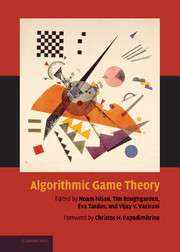Refine search
Actions for selected content:
48202 results in Computer Science
Contents
-
- Book:
- Next-Generation Internet
- Published online:
- 05 October 2012
- Print publication:
- 03 February 2011, pp vii-xv
-
- Chapter
- Export citation
5 - Grid networking
- from Part I - Enabling technologies
-
-
- Book:
- Next-Generation Internet
- Published online:
- 05 October 2012
- Print publication:
- 03 February 2011, pp 88-104
-
- Chapter
- Export citation
Plate section
-
- Book:
- Human Attention in Digital Environments
- Published online:
- 04 February 2011
- Print publication:
- 03 February 2011, pp -
-
- Chapter
- Export citation
12 - Multi-path BGP: motivations and solutions
- from Part III - Protocols and practice
-
-
- Book:
- Next-Generation Internet
- Published online:
- 05 October 2012
- Print publication:
- 03 February 2011, pp 238-256
-
- Chapter
- Export citation
Asymptotics for First-Passage Times on Delaunay Triangulations
-
- Journal:
- Combinatorics, Probability and Computing / Volume 20 / Issue 3 / May 2011
- Published online by Cambridge University Press:
- 03 February 2011, pp. 435-453
-
- Article
- Export citation
11 - Separating routing policy from mechanism in the network layer
- from Part III - Protocols and practice
-
-
- Book:
- Next-Generation Internet
- Published online:
- 05 October 2012
- Print publication:
- 03 February 2011, pp 219-237
-
- Chapter
- Export citation
8 - PHAROS: an architecture for next-generation core optical networks
- from Part II - Network architectures
-
-
- Book:
- Next-Generation Internet
- Published online:
- 05 October 2012
- Print publication:
- 03 February 2011, pp 154-178
-
- Chapter
- Export citation
13 - Explicit congestion control: charging, fairness, and admission management
- from Part III - Protocols and practice
-
-
- Book:
- Next-Generation Internet
- Published online:
- 05 October 2012
- Print publication:
- 03 February 2011, pp 257-274
-
- Chapter
- Export citation
ROB volume 29 issue 2 Cover and Front matter
-
- Article
-
- You have access
- Export citation
ROB volume 29 issue 2 Cover and Back matter
-
- Article
-
- You have access
- Export citation
Assessing user simulation for dialog systems using human judges and automatic evaluation measures
-
- Journal:
- Natural Language Engineering / Volume 17 / Issue 4 / October 2011
- Published online by Cambridge University Press:
- 01 February 2011, pp. 511-540
-
- Article
- Export citation
Degenerations and limit Frobenius structures in rigid cohomology
- Part of
-
- Journal:
- LMS Journal of Computation and Mathematics / Volume 14 / 2011
- Published online by Cambridge University Press:
- 01 February 2011, pp. 1-33
-
- Article
-
- You have access
- Export citation
Growth in Baumslag–Solitar groups I: subgroups and rationality
- Part of
-
- Journal:
- LMS Journal of Computation and Mathematics / Volume 14 / 2011
- Published online by Cambridge University Press:
- 01 February 2011, pp. 34-71
-
- Article
-
- You have access
- Export citation
Discovering bipartite substructure in directed networks
- Part of
-
- Journal:
- LMS Journal of Computation and Mathematics / Volume 14 / 2011
- Published online by Cambridge University Press:
- 01 February 2011, pp. 72-86
-
- Article
-
- You have access
- Export citation

Algorithmic Game Theory
-
- Published online:
- 31 January 2011
- Print publication:
- 24 September 2007
Choquet–Kendall–Matheron theorems for non-Hausdorff spaces
-
- Journal:
- Mathematical Structures in Computer Science / Volume 21 / Issue 3 / June 2011
- Published online by Cambridge University Press:
- 28 January 2011, pp. 511-561
-
- Article
- Export citation
CPC volume 20 issue 2 Cover and Front matter
-
- Journal:
- Combinatorics, Probability and Computing / Volume 20 / Issue 2 / March 2011
- Published online by Cambridge University Press:
- 28 January 2011, pp. f1-f2
-
- Article
-
- You have access
- Export citation
CPC volume 20 issue 2 Cover and Back matter
-
- Journal:
- Combinatorics, Probability and Computing / Volume 20 / Issue 2 / March 2011
- Published online by Cambridge University Press:
- 28 January 2011, pp. b1-b2
-
- Article
-
- You have access
- Export citation
Non-Degenerate Spheres in Three Dimensions
-
- Journal:
- Combinatorics, Probability and Computing / Volume 20 / Issue 4 / July 2011
- Published online by Cambridge University Press:
- 28 January 2011, pp. 503-512
-
- Article
- Export citation
